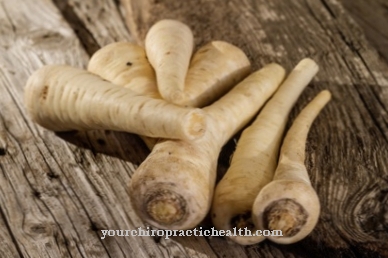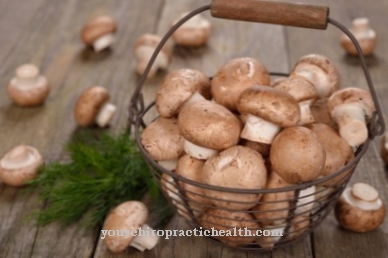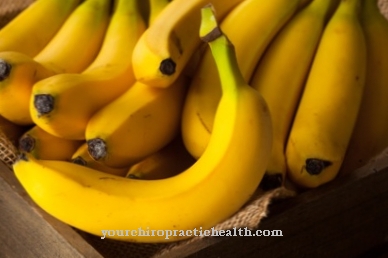The soy milk is a drink made from the soy plant. The ingredients are also exclusively of vegetable origin. This has made soy milk very popular, especially in the area of vegan nutrition.
What you should know about soy milk

Soy milk originally comes from China. It has been used here for around 2,000 years. It was only a few years ago that it gained increasing popularity in Germany. With the increasing popularity of the vegan diet, soy milk was also promoted in western countries.
Compared to cow's milk, however, it is still a niche product. The name soy milk, although it has established itself in parlance, is not a valid name, because soy milk is based more on a soy drink, because the term milk is only used for liquids that obtained from udders. With regard to the taste, soy milk takes some getting used to for real milk fans. However, once you have got used to the taste, which is somewhat reminiscent of grain and is usually slightly sweet, you will often appreciate it. The soy milk is slightly creamy, looks like milk and can be used in exactly the same way.
Importance to health
Soy milk has many health benefits. Compared to cow's milk, it contains more protein and iron as well as less overall fat, calories and saturated fatty acids. The calcium content is one sixth lower than that of cow's milk.
Calcium is added to some products in order to achieve a level similar to that in cow's milk. This can be found in the list of ingredients. Soymilk is cholesterol-free and low in purine, so it is particularly suitable for nutrition with a lipid metabolism disorder and gout or with an elevated uric acid level. Soy milk is very important as a substitute for cow's milk in the case of cow's milk allergy or lactose intolerance. Many people wonder whether soy milk is healthier than cow's milk. This question can be answered in the affirmative, unless there is an allergic reaction to the soy protein. Soy milk scores particularly well when it comes to protein. Although it contains less than is the case with cow's milk, the body can use soy protein almost 1: 1 compared to proteins from animal origin.
This effect is particularly beneficial for vegans and vegetarians. In terms of fat content, soy milk is in the middle between whole milk with 3.5 percent and low-fat milk with 1.5 percent. However, unlike cow's milk, the fat in soy milk consists primarily of healthy unsaturated fatty acids, which have a beneficial effect on the heart and circulation. Another advantage compared to cow's milk is the folic acid content, because soy milk provides around four times as much. This makes them a healthy drink for pregnant women too. It also contains healthy plant substances such as flavonoids and saponins. If you want to be sure about genetic engineering, you should buy organic quality soy milk.
Ingredients & nutritional values
| Nutritional information | Amount per 100 gram |
| Calories 54 | Fat content 1.8 g |
| cholesterol 0 mg | sodium 51 mg |
| potassium 118 mg | carbohydrates 6 g |
| Fiber 0.6 g | protein 3.3 g |
In terms of nutrients, soy milk can be compared to cow's milk to some extent. It contains similar amounts of protein, calories, and fats. However, unlike cow's milk, it provides the body with the important unsaturated fatty acids that it cannot produce itself. They are essential for a healthy diet.
The vitamin E content is also higher in soy milk. However, in comparison to cow's milk, it does not contain any vitamin B12. Soy milk also has very low levels of calcium. Attention should be paid to a balance here. The situation is different if the soy milk is fortified with additional calcium. The great advantage of soy milk is that people who suffer from lactose intolerance can consume a milk-like drink.
Intolerances & allergies
The soy milk can cause allergies. The reason for this is the contained soy protein, which is occasionally responsible for food allergies. Especially if you are allergic to birch pollen, eating soy milk can lead to a cross allergy.
The symptoms of a soy allergy are manifold, for example gastrointestinal complaints, nausea, vomiting, diarrhea, eczema flare-ups, problems of the skin or respiratory tract up to anaphylactic shock. Soy milk should not be consumed if you have an allergy.
Shopping & kitchen tips
When buying soy milk, various products are available, for example with or without sugar, with or without calcium, natural soy milk or soy milk from organic farming. The prices are quite different, but say little about the quality of the soy milk.
It is therefore always advisable to take a closer look at the list of ingredients. Regarding storage, it should be said that ultra-high temperature soy milk can be stored for up to a year without refrigeration. Of course, the best-before date must always be observed. Once the soy milk has been opened, it has to be stored in the refrigerator, just as it is with real UHT milk. Here it stays fresh for about two to three days.
Preparation tips
Soy milk can be used in many ways in the kitchen. In principle, it can be used in a similar way to milk. Soy milk is suitable for cooking, baking and the preparation of rice pudding, puddings, semolina dishes, desserts, muesli and mixed drinks such as smoothies or hot chocolate. Soy milk can also be used to refine soups, tea or coffee.
It can also replace creme fraiche, sour cream or quark in a wide variety of dishes such as desserts or sauces. In this case, however, it is important that the soy milk does not contain any flavoring ingredients. Soy milk is mainly used in vegan and vegetarian diets to prepare dishes without animal ingredients. There are a large number of recipes in which soy milk is used, especially in Asian, Chinese and Japanese cuisine. The soy milk can also be made very easily yourself: 100 grams of soybeans are soaked in water overnight. This is then poured off and mashed with 320 ml of fresh water to a fine pulp.
In a large saucepan, 660 ml of water are brought to the boil and stirred into the porridge. Simmer over low heat for 10 minutes, remove from heat and let cool. Then a sieve is covered with a kitchen towel and hung over a bowl. The beans are poured in with the liquid and allowed to drain. Finally, 260 ml of water are added to the sieve. The cloth is well wrung out over the bowl. The resulting soy milk is covered and placed in the cold and used depending on the recipe.













.jpg)

.jpg)
.jpg)











.jpg)